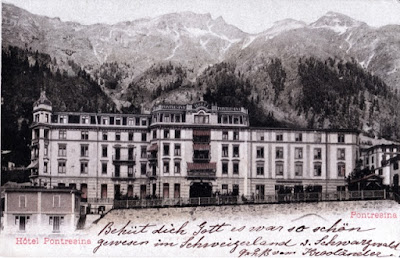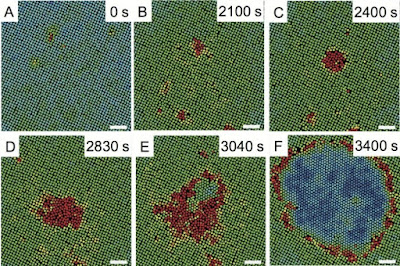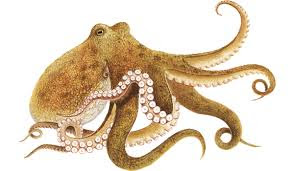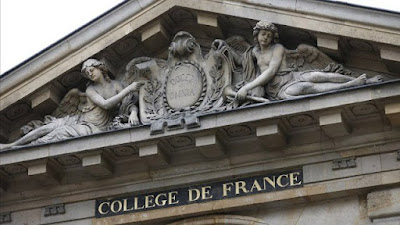Georg Lukács in 1962 used the colorful image of a fictional "Grand Hotel Abyss" to express his disappointment in the theorists of the Frankfurt School. Here is a passage in which the idea is described in "Preface to the Theory of the Novel" (link):
A considerable part of the leading German intelligentsia, including Adorno, have taken up residence in the ‘Grand Hotel Abyss’ which I described in connection with my critique of Schopenhauer as ‘a beautiful hotel, equipped with every comfort, on the edge of an abyss, of nothingness, of absurdity. And the daily contemplation of the abyss between excellent meals or artistic entertainments, can only heighten the enjoyment of the subtle comforts offered.’ (The fact that Ernst Bloch continued undeterred to cling to his synthesis of ‘left’ ethics and ‘right’ epistemology (e.g. cf. Frankfurt 1961) does honour to his strength of character but cannot modify the outdated nature of his theoretical position. To the extent that an authentic, fruitful and progressive opposition is really stirring in the Western world (including the Federal Republic), this opposition no longer has anything to do with the coupling of ‘left’ ethics with ‘right’ epistemology.)The thinkers of the Frankfurt School -- Adorno, Horkheimer, Habermas, Benjamin, Wellmer, Marcuse -- were for Lukács too much devoted to theorizing capitalism and barbarism and too little about changing it. They were like imagined world-weary residents in the Grand Hotel Abyss, observing the unfolding catastrophe but doing nothing to intervene to stop it. They were about theory, not praxis.
Stuart Jeffries uses this trope as the organizing theme of his group biography of these figures in Grand Hotel Abyss: The Lives of the Frankfurt School, and, in a word, he finds that Lukács's critique is unfounded.
Jeffries emphasizes the common social origins of these boundary-breaking critics of capitalism. The book is detailed and insightful. Jeffries emphasizes the common social and cultural origins of almost all these men -- German, Jewish, bourgeois, affluent -- and the common threads of their criticism of the capitalism and consumerism that surrounded them in the early and middle twentieth century. The central question of how it came to pass that ordinary people in cultured, philosophically rich Germany came to support the Nazi rise to power was of vital concern to all of them. But consumerism, authoritarianism, and the suffering both created by and hidden by capitalism are also in the center stage.
The book is primarily about ideas and debates, not the particulars of personal biography. Jeffries does an impressive job of walking readers through the debates that swirled within and across the Frankfurt School -- is capitalism doomed? Are workers inherently revolutionary? Is art part of the support system for capitalism? Is Marxism scientific or dialectical? Jeffries does an exceptional and fascinating job of telling this complex story of intellectual history and social criticism.
A particularly important innovation within the intellectual tradition of critical theory was the pointed critique these theorists offered of mass culture. Unlike orthodox Marxists who gave primary emphasis to the workings of the forces and relations of production -- economics -- the critical theorists took very seriously the powerful role played within advanced capitalism by mass culture, film, media, and television. (The publication in 1927 of Marx's Economic and Philosophic Manuscripts of 1844 appears to have been an important impetus to much of the theorizing of the Frankfurt School.) Here is one example of the social criticism of Hollywood offered by Adorno and Horkheimer in Dialectic of Enlightenment:
Consider, for instance, Donald Duck. Once, such cartoon characters were ‘exponents of fantasy as opposed to rationalism’, wrote Adorno and Horkheimer. Now they had become instruments of social domination. ‘They hammer into every brain the old lesson that continuous friction, the breaking down of all individual resistance, is the condition of life in this society. Donald Duck in the cartoons and the unfortunate in real life get their thrashing so that the audience can learn to take their own punishment.’ (225)So what is a more progressive role for works of art and culture to play in a society embodying serious social exploitation and domination? One work that was an important point of consideration for several theorists was the Brecht and Weill opera, Rise and Fall of the City of Mahogany. Adorno and others regarded this work as one that gave appropriate and unblinking attention to the suffering of the modern social order.
Brecht’s libretto, too, sought to make it clear that the bourgeois world was absurd and anarchic. ‘In order to represent this convincingly’, wrote Adorno of the dramatisation of the bourgeois world as absurd and anarchic, ‘it is necessary to transcend the closed world of bourgeois consciousness which considers bourgeois social reality to be immutable. Outside of this framework, however, there is no position to take – at least for the German consciousness, there is no site which is non-capitalist.’ This was to become one great theme of critical theory: there is no outside, not in today’s utterly rationalised, totally reified, commodity-fetishising world. When Marx wrote Capital in the mid nineteenth century, the more primitive capitalist system he was diagnosing made commodity fetishism merely episodic; now it was everywhere, poisoning everything. ‘Paradoxically, therefore’, Adorno added, ‘transcendence must take place within the framework of that which is.’ Brecht’s assault on capitalist society in Mahoganny was then paradoxically both from within and from without at the same time, both immanent and transcendent. (132)Jeffries also provides a fascinating and extended discussion of the deep interactions that occurred between Thomas Mann and Adorno in Los Angeles as Mann worked at completing Doctor Faustus. Mann wanted Adorno's expert advice about modern music, and Adorno obliged. Jeffries argues that Adorno had a substantive effect on the novel:
Arguably, the finished novel reflects Adorno’s melancholic philosophy more profoundly than Mann’s. This is not to suggest plagiarism: as Adorno wrote in 1957, the insinuation that Mann made illegitimate use of his ‘intellectual property’ is absurd. The underlying aesthetic philosophy of the novel goes beyond the binary opposition between the Apollonian and Dionysian, between the orderly and the ecstatic, that Nietzsche set out in The Birth of Tragedy and to which Mann repeatedly appealed in his fiction... During the collaboration with Adorno, however, Mann set aside his original, Dionysian conception of the composer and as a result Leverkühn became something much more interesting –a figure who dramatised something of the Frankfurt School’s, and in particular Adorno’s, distinctive contribution to the philosophy of art. (243)And what about fascism? This was a central thrust of Frankfurt School research, and opinion was divided about the causes of the rise of Nazism in Germany among the Frankfurt School theorists. But here is an interpretation that seems particularly relevant in 2016 in the United States, given the pageantry of political rallies and the slogans about making America great again:
Fascism was, as a result, a paradox, being both ancient and modern: more precisely it was a system that used a tradition hostile to capitalism for the preservation of capitalism. For Bloch, as for Walter Benjamin, fascism was a cultural synthesis that contained both anti-capitalist and utopian aspects. The Frankfurt School failed to emphasise in its analysis of fascism what Benjamin called the ‘aestheticisation of politics’. It fell to Benjamin, Bloch and Siegfried Kracauer to reflect on the Nazi deployment of myths, symbols, parades and demonstrations to command support. (250)The chapter on Habermas is also very good and can be read separately as an introduction to Habermas's leading ideas (chapter 17). It is significant that this final voice of the Frankfurt School should be one that provides a basis for greater optimism about the prospects for modern democracy than what emerges from the Dialectic of Enlightenment.
The perspectives of the Frankfurt School were developed in the context of crises of capitalism, fascism, and anti-semitism in the 1930s. But these theories are once again deeply relevant in the context of the politics of 2016. A xenophobic, divisive candidate and party have assumed the reins of power in a populous democracy. The issues of propaganda and unapologetic political lies are before us once again. The politics of hate and intolerance have taken center stage. And the role of culture, media, and now the internet needs to be examined carefully for its dependence upon the corporate order as well as its possible potency as a mechanism of resistance. The Frankfurt School thinkers had important insights into virtually all these questions. Jeffries' very interesting intellectual history of the movement is timely.
Jeffries quotes from a letter from Adorno to Mann on the aftermath of Nazism in Germany with observations that may be relevant to us today as well:
The inarticulate character of apolitical conviction, the readiness to submit to every manifestation of actual powers, the instant accommodation to whatever new situation emerges, all this is merely an aspect of the same regression. If it is true that the manipulative control of the masses always brings about a regressive formation of humanity, and if Hitler’s drive for power essentially involved the relationship of this development ‘at a single stroke’, we can only say that he, and the collapse that followed, has succeeded in producing the required infantilisation. (273)These are words that may be important in the coming years, if the incoming government succeeds in carrying out many of its hateful promises. And how will the institutions of media and culture respond? Let us not be infantilized in the years to come when it comes to the fundamental values of democracy.










